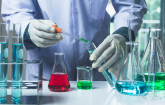Green Science Alliance Developed Lithium Sulfur Battery as Next Generation Rechargeable Battery
KWANISHI-CITY, Japan, Oct. 6, 2020 /PRNewswire/ -- Rechargeable batteries are a very important device because they can store electricity produced by sustainable energy such as wind power, solar cells and fuel cells. Therefore, the challenge to increase the capacity of rechargeable batteries is an extremely important task.
Lithium ion batteries are one of the most popular rechargeable batteries nowadays and researchers have been challenging to make various type of electrodes, electrolyte materials in order to create lithium ion batteries with stronger electrochemical properties. LiCoO2, ternary oxide such as LiNi0.33Mn0.33Co0.33O2, LiFePO4 as olivine cathode, LiNi0.5Mn1.5O4 as high voltage cathode with spinel structure and lithium rich cathode etc. have been intensively under development and some of them have already been commercialized for practical use. Anode, carbon, metal oxide and silicon-based materials have been commercialized. With these efforts, lithium ion batteries exhibit average voltage as high as 3.0 – 4.2 V and capacity as much as 150 - 250 mAhg-1.
In order to build up a society based on sustainable energy such as solar cell, wind power, hydrogen power, fuel cells, geothermal power, wave power and biomass power generation etc., it is necessary to create rechargeable batteries with higher voltage, higher capacity, better charge-discharge cycle characteristics with high durability.
All solid-state batteries, metal air batteries, multi-valent ion batteries etc. have been candidates for next generation rechargeable batteries and the lithium sulfur battery is also one. Sulfur as active material possess more than 5 times of theoretical energy density than that of cathode which is used for current lithium ion batteries. Electrochemical reaction occurs between sulfur and lithium as oxidation reduction process. Theoretical capacity of sulfur is 1672mAh/g and that is much higher than that of transition metal oxide type cathode. Since lithium sulfur batteries can possess such high energy density, it is expected to be used for unmanned aerial vehicle, drone and higher power EV etc.
Green Science Alliance is the company that focuses in researching cutting edge technology in the field of energy and environmental green science. One of their businesses is developing next generation rechargeable battery. They synthesize electrode, electrolyte material themselves. In addition, they make coating ink, testing battery, measure their electrochemical properties, and analyze technical detail, all procedures can be done within their company, which could be one of advantage compared to other competitors.
This time, Mr. Hiromichi Itani and Dr. Ryohei Mori at Green Science Alliance have developed lithium sulfur batteries as next generation rechargeable battery. Testing battery was prepared with their sulfur carbon composite cathode, lithium metal as anode, and their original electrolyte. As a result, cell exhibited more than 1000 mAh/g as initial stage and became a little more than 400 mAh/g after 100 charge-discharge cycles. This electrochemical measurement was performed with 0.1 C of charge discharge electrical current at room temperature. Green Science Alliance will keep challenging to increase the cell capacity and to obtain stable charge discharge cycles. They are also planning to manufacture lithium sulfur batteries for practical use.
Contact:
Ryohei Mori
+81727598501
[email protected]
SOURCE Green Science Alliance Co., Ltd.

WANT YOUR COMPANY'S NEWS FEATURED ON PRNEWSWIRE.COM?
Newsrooms &
Influencers
Digital Media
Outlets
Journalists
Opted In





Share this article